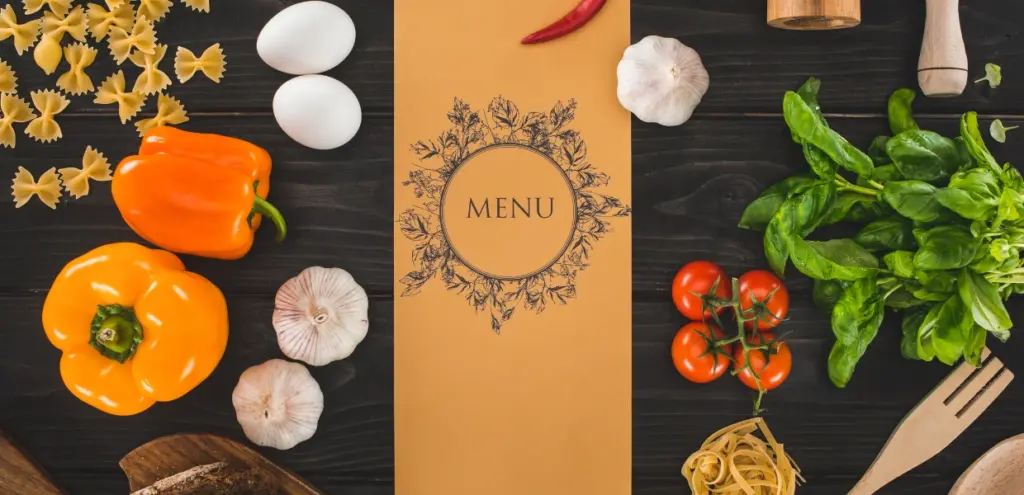All Articles
How to Craft the Perfect Restaurant Menu

A restaurant menu is more than a mere list of dishes; it’s a crucial tool that conveys the essence of your establishment, entices customers, and enhances profitability. Crafting the ideal menu requires a careful blend of culinary creativity, strategic planning, and a deep understanding of your target audience. In this article, I will explore the essential elements of designing a menu that not only delights the palate but also elevates the dining experience and drives your restaurant’s success—guiding you through the process if you are opening your own restaurant.
Understanding Your Brand and Concept
Before you begin selecting dishes or designing layouts, it is imperative to have a clear grasp of your restaurant’s identity. Are you positioning yourself as a cozy Italian trattoria, a high-end sushi bar, or a family-friendly diner? Your restaurant menu should reflect this identity, aligning with your establishment’s ambiance, decor, and overall concept.
Understanding your target audience is equally important. Consider the demographics, preferences, and expectations of the customers you aim to attract. Health-conscious millennials may gravitate toward a restaurant that offers wholesome, nutritious options, while families with young children might prefer comfort food. On the other hand, business professionals often seek quick yet refined meals. By tailoring your menu to meet these varied needs while staying true to your brand, you ensure your offerings resonate with your patrons.
Setting clear objectives for your menu is another foundational step. Decide what you want to achieve—whether it is showcasing innovative culinary techniques, highlighting local and seasonal ingredients, or offering comfort food favorites. Defining goals will guide your menu development process and help maintain consistency.
Menu Engineering and Item Selection
Once you have a solid understanding of your brand and audience, the next step is to select the items that will feature on your menu strategically. Menu engineering is a technique that involves analyzing the profitability and popularity of each dish to optimize sales and maximize profits.
By categorizing your menu items based on their performance—identifying them as stars (high profit, high popularity), plowhorses (low profit, high popularity), puzzles (high profit, low popularity), or dogs (low profit, low popularity)—you can make informed decisions about which dishes to promote, adjust, or remove. This analytical approach ensures that every item on your menu serves a purpose and contributes positively to your bottom line.
For example, highlight your star dishes prominently on the menu to draw attention to them. For plowhorses, consider adjusting portion sizes or slightly increasing prices to improve profitability without sacrificing customer satisfaction. Puzzles might benefit from enhanced descriptions or better placement on the menu to boost their appeal, while dogs may need to be reevaluated or phased out to make room for more promising offerings.
Strategic Pricing
Pricing your menu items is both an art and a science. It requires a careful balance between covering costs, achieving desired profit margins, and providing perceived value to your customers. Start by calculating the cost of each dish, including ingredients, preparation, and overhead expenses. This detailed cost analysis will inform your pricing decisions and ensure each item contributes to your financial goals.
Psychological pricing strategies can also influence customer perceptions and purchasing behavior. For instance, charm pricing—setting prices that end in .99 or .95—can make items appear less expensive. Anchoring higher-priced items near standard options can make the latter seem more affordable by comparison. Additionally, some studies suggest that omitting currency symbols can subtly encourage customers to spend more, as it reduces the emphasis on cost.
Menu Layout and Design

The visual presentation of your menu plays a significant role in influencing customer choices. A well-designed menu guides the diner’s eye to the items you most want to sell and enhances the overall dining experience.
Organize your menu in a logical and coherent manner, typically starting with appetizers, progressing through main courses, and concluding with desserts. Within each section, strategically place high-profit or signature dishes where they are most likely to be noticed. The “golden triangle” theory suggests that customers’ eyes naturally move from the center to the top right and then to the top left of a menu page, so positioning critical items in these areas can increase their visibility.
Typography and readability are also essential considerations. Choose fonts that reflect your brand’s personality but remain easy to read. Establish a clear hierarchy with headings and subheadings, and use spacing effectively to prevent the menu from feeling cluttered. If you opt to include images, ensure they are high-quality and appetizing, but be cautious not to overcrowd the menu with too many visuals.
Color psychology can subtly influence diners’ emotions and appetites. Warm colors like red and orange are known to stimulate hunger, while cooler tones can convey a sense of sophistication or calmness. Select a color palette that aligns with your restaurant’s ambiance and the mood you wish to evoke.
If you want your menu design to be a masterpiece, do not hesitate to consult a specialist who can help you craft the perfect restaurant menu.
Descriptive Menu Writing
The language you use to describe your dishes can significantly impact a customer’s desire to order them. Employing evocative and sensory-rich descriptions can make menu items more enticing and justify higher price points.
Incorporate adjectives that appeal to the senses, such as “succulent,” “crisp,” or “velvety,” to stimulate the imagination and appetite. Highlight the uniqueness of your offerings by using terms like “artisan,” “homemade,” or “handcrafted.” Telling a story about a dish—its origins, the inspiration behind it, or the care taken in its preparation—can create an emotional connection with the customer.
However, it’s important to balance creativity with clarity. Ensure that descriptions are accurate and provide essential information about ingredients and preparation methods, especially for customers with dietary restrictions or preferences.
Menu Variety and Balance
Offering a diverse yet cohesive restaurant menu is key to satisfying a wide range of customer tastes without overwhelming them. Strive for a balance in flavors, textures, and cooking techniques to provide a well-rounded dining experience.
Consider dietary considerations by including options for various needs and lifestyles. Mark vegetarian, vegan, gluten-free, or nut-free dishes, and be mindful of common allergens. Offering a mix of lighter and more indulgent options allows customers to choose according to their appetite and dietary goals.
Portion sizes and pricing should also be varied to accommodate different dining occasions, from quick lunches to leisurely dinners. Including small plates or sharing options can encourage customers to try multiple dishes and enhance their overall experience.
Seasonal and Local Ingredients
Incorporating seasonal and locally sourced ingredients can enhance the quality of your dishes and appeal to environmentally conscious diners. Seasonal ingredients are often fresher and more flavorful, allowing your chefs to showcase the best of what each season has to offer.
Highlighting local produce not only supports the community but also reduces your carbon footprint. It can also provide a unique selling point, as customers increasingly value sustainability and ethical sourcing. Regularly updating your menu to reflect seasonal changes keeps it fresh and encourages repeat visits from patrons eager to try new offerings.
Legal and Regulatory Compliance
Ensuring your menu adheres to local laws and regulations is essential to avoid legal issues and build customer trust. This includes providing accurate allergen information, especially in regions where it is legally required. Transparent pricing is also important; indicate whether taxes are included or extra to prevent misunderstandings.
Be cautious when using trademarked names or branded ingredients. Unauthorized use can lead to legal complications, so it is best to avoid protected names unless you have obtained the necessary permissions.
Staff Training
Your menu is only as effective as the staff who present it. Comprehensive training ensures your team can confidently guide customers through the menu, answer questions, and make informed recommendations.
Equip your staff with in-depth knowledge of each dish, including ingredients, preparation methods, and potential allergens. Teaching them upselling techniques—such as suggesting appetizers, sides, or beverages that complement main dishes—can enhance the dining experience and increase sales.
Creating a feedback loop between the kitchen, service staff, and management can provide valuable insights into customer preferences and perceptions, allowing for continuous improvement of your menu offerings.
Testing and Iteration
A successful menu is not static; it evolves based on performance data and customer feedback. Regularly analyze sales reports to identify trends, such as which dishes are most popular or underperforming. Solicit feedback through surveys, comment cards, or online reviews to better understand customer satisfaction.
Consider introducing specials or limited-time offerings to test new dishes before adding them permanently to the menu. This approach allows you to gauge customer interest and refine recipes based on real-world responses.
Digital Menu Considerations

In today’s digital age, your menu extends beyond the physical copy in your restaurant. An up-to-date, user-friendly online menu is crucial for attracting new customers and accommodating those who prefer to browse options digitally.
Ensure your menu is easily accessible on your website and optimized for mobile devices. High-quality images and accurate, enticing descriptions are just as important online as in-house. If your restaurant offers delivery or partners with third-party platforms, keep those menus current to prevent discrepancies and customer frustration.
Interactive features, such as clickable sections or the ability to filter by dietary preferences, can enhance the user experience. QR codes leading to your digital menu can also be a hygienic and convenient option for in-restaurant guests.
Also, by implementing a QR table ordering system, you not only provide customers with a personalized digital menu but also give them the convenience of ordering and paying directly from their mobile phones. This streamlines your restaurant operations, enhancing efficiency and improving the overall dining experience.
Cost Control and Profitability
Behind every successful menu is a solid understanding of cost control. Efficient inventory management, such as cross-utilizing ingredients across multiple dishes, can reduce waste and lower food costs. Standardizing recipes and portion sizes ensures consistency and helps maintain profit margins.
Building solid relationships with suppliers can lead to better pricing and more reliable access to high-quality ingredients. Regularly reviewing supplier contracts and exploring alternative options can also contribute to cost savings.
Menu Accessibility
Making your menu accessible to all guests is not only good practice but can also expand your customer base. Providing menus in multiple languages caters to tourists and multilingual communities. Using larger fonts and high-contrast colors aids those with visual impairments.
Offering alternative formats, such as braille menus or digital versions compatible with screen readers, demonstrates inclusivity and enhances the dining experience for guests with disabilities.
Protecting Your Intellectual Property
Your menu and recipes are valuable assets. Protect them by understanding your rights and taking appropriate legal measures. Registering trademarks for unique dish names or branding elements can prevent others from using them without permission.
Implement confidentiality agreements with staff to safeguard proprietary recipes and preparation methods. While sharing enough information to market your dishes effectively is important, maintaining some secrecy can preserve your competitive edge.
Embracing Sustainability and Ethics
Modern diners are increasingly mindful of environmental and ethical considerations. Demonstrating your commitment to sustainability can differentiate your restaurant and appeal to conscious consumers.
Use eco-friendly materials for your physical menus, such as recycled paper or biodegradable options. Highlighting ethical sourcing—such as fair-trade coffee, sustainably caught seafood, or free-range meats—can enhance your brand image.
Engaging with the local community through partnerships or charitable initiatives benefits society and can foster customer loyalty.
Conclusion
Crafting the perfect restaurant menu is a multifaceted endeavor that combines creativity, strategic thinking, and a deep understanding of your customers and brand. By carefully selecting dishes, employing effective pricing strategies, and designing an appealing and accessible menu, you create a powerful tool that enhances the dining experience and drives your restaurant’s success.
Remember that a menu is a dynamic entity. Regularly reviewing and updating it in response to customer feedback, seasonal changes, and industry trends keeps your offerings fresh and exciting. Investing time and resources into perfecting your menu is an investment in your restaurant’s future, promising satisfied customers and sustained profitability.
 12 October 2024
12 October 2024 7 min read
7 min read

